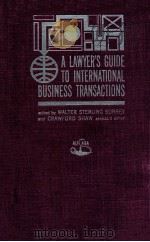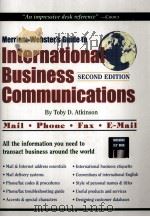《A LAWTER'S GUIDE TO INTERNATIONAL BUSINESS TRANSACTIONS》
| 作者 | 编者 |
|---|---|
| 出版 | JOINT COMMITTEE ON CONTUING LEGAL EDUATION |
| 参考页数 | 1071 |
| 出版时间 | 1963(求助前请核对) 目录预览 |
| ISBN号 | 无 — 求助条款 |
| PDF编号 | 812918628(仅供预览,未存储实际文件) |
| 求助格式 | 扫描PDF(若分多册发行,每次仅能受理1册) |

Section Ⅰ UNITED STATES LAW GOVERNING INTERNATIONAL TRADE1
Preface2
THE TRADE AGREEMENTS PROGRAM3
Introduction3
Background of the Trade Agreements Program4
The Trade Expansion Act of 19627
Tariff-Cutting Authority7
Import Restrictions to Offset Unreasonable,Unjustifiable or Discriminatory Acts of Foreign Countries11
Safeguards Against Injury14
Adjustment Assistance22
Orderly Marketing Agreements36
National Security Amendment37
Section 22 of the Agricultural Adjustment Act38
Administration of the Program39
LAWS AND REGULATIONS AFFECTING UNITED STATES TRADE43
Introduction43
General Agreement on Tariffs and Trade(GATT)43
Tariff Schedules44
General Provisions Governing Import and Export Trade46
Organization49
Constitutionality of United States Participation in GATT51
Antidumping Legislation52
Procedure Before the Treasury Department and Tariff Commission52
Regulations53
Appellate Procedures53
Countervailing Duties54
Procedure Before the Treasury Department54
Judicial Review55
The Buy American Act55
Administrative Procedures56
Export Controls56
Summary of Current Law and Program57
The Regulatory System Under the Export Control Act60
Summary of Related Statutes in the Export Control Field63
Detailed Scope and Procedures Under Export Control Act65
Procedure for Making a General License Exportation70
The System for Individual and Other Validated Export Licenses70
Control of Technical Data79
Enforcement:Sanctions Which May Be Imposed When Export Control Violations Occur81
Trading with the Enemy Act85
Regulations Issued Under Section 5(b)86
Transactions Covered87
Bibliography93
Appendix101
Section Ⅱ INDUSTRIAL FOREIGN LICENSING ARRANGEMENTS105
Preface106
INDUSTRIAL FOREIGN LICENSING AGREEMENTS107
Introduction107
Advantages and Disadvantages of Licensing107
Types of Licenses108
Categories of Licensees110
Categories of Licensors111
Types of Statutory Industrial Property Rights111
Patents Overseas113
The International Convention114
Classification of Foreign Patents115
"Working" of Patents116
Trademarks Overseas117
"Registered-User" Countries118
Remedies in Case of Infringement121
Types of Non-Statutory Industrial Property Rights122
Licenses and Assignments122
Protection of Non-Statutory Rights123
Licenses by Implication124
Difference Between Know-How and Trade Secrets124
Trade Secrets Under Case Law125
Broader Concepts of Know-How127
Know-How in Antitrust Cases127
Possible Limited Use of Term "Trade Secrets"130
Basic Provisions in License Contracts130
Preambles and Whereas Clauses130
Provisions Describing "Fields" and the Like131
Products-Improvements and New Developments133
Know-How and Technical Data134
Grant of Rights135
Quality Supervision136
Technical Aid and Assistance136
Weights and Measures137
Supply of Parts and Equipment138
Royalties and Fees138
Variable Rates143
Other Payment Protection Provisions144
Miscellaneous Provisions146
Additional Problems in Foreign Licensing147
Antitrust Considerations147
Registration and Recordation of Contracts149
U.S. Tax Considerations150
"Base Companies" Under 1962 Revenue Act150
Bibliography153
Appendix161
Section Ⅲ FOREIGN LAW ASPECTS OF DIRECT INVESTMENT ABROAD181
Preface182
FOREIGN LAW ASPECTS OF DIRECT INVESTMENT ABROAD183
Introduction183
Role of the American Lawyer185
Incentives and Restrictions187
Forms of Business Organization(Foreign Company Law)188
Foreign Branch of Domestic Parent189
Foreign Branch of U.S.Subsidiary190
Foreign Branch of a Foreign "Base Company"190
Foreign Subsidiary190
Corporation(SociétéAnonyme,Sociedad Anonima,Aktien-gesellschaft)191
Private Company and Public Company194
Limited Liability Company(Société à Responsabilité Limitée,Sociedad de Responsabilidad Limitada,or Gesellschaft mit Beschrankter Haftung)194
The Partnership(Société en Nora Collectif,Sociedad Colectiva,Offeva Handelsgesellschaft)195
Joint Ventures196
Participation by Local Government196
Voluntary Participation With Local Capital198
Exchange Controls200
Rates of Exchange201
Convertibility203
Relaxation of Exchange Controls to Encourage Foreign Investment204
Convertibility Guaranties204
Exchange Controls and the International Monetary Fund205
Relationship of Import Restrictions to Exchange Controls205
Relaxation of Import Restrictions205
Foreign Tax Laws206
Range of Rates206
Types of Taxes208
Tax Incentives210
Tax Treaties211
Regulation of Business211
Foreign Labor Laws212
Wage Scales213
Labor Benefits213
Profit Sharing213
Vested Rights in a Job214
Measures to Insure Use of Local Labor214
Bibliography215
Appendix267
Section ⅣLEGAL PROTECTION OF INTERNATIONAL BUSINESS TRANSACTIONS299
Preface300
LEGAL PROTECTION OF INTERNATIONAL TRANSACTIONS AGAINST NON-COMMERCIAL RISKS301
Introduction301
Legal Protection Under Local Law304
Assurances Applicable to Direct Investments of Foreign Capital306
Assurances Applicable to Know-How Agreements and U.S. Exports308
Enforcement of Rights Under Local Law310
Legal Protection Under International Law311
Customary International Law311
Responsibility for Taking of an Alien's Property314
Responsibility for Breach of Undertaking to Alien316
Protection Under Customary International Law for Know-How Agreements and U.S. Exports321
Bilateral Treaties of Friendship and Commerce322
Problems of Enforcement of Rights Under International Law331
Proposals for Multilateral Measures for the Protection of Foreign Investment332
Legal Protection of International Transactions Under United States Law336
Investment Guaranty Program336
Export Credit Insurance346
Other Aspects of United States Law354
Conclusion357
Bibliography359
Appendix369
Section Ⅳ FINANCING OF INTERNATIONAL BUSINESS TRANS-ACTIONS387
Preface390
EXPORT-IMPORT BANK391
Introduction391
Statutory Authority and Functions391
Financial Resources393
Types of Assistance Available393
Direct Financing-Project Credits394
Loans for Relending396
Emergency Foreign Trade Credits397
Agricultural Commodity Credits397
Exporter Credits-General Medium-Term Requirements397
Participation with Commercial Banks in Medium-Term Financing398
Guarantees and Insurance399
Commercial Bank Guarantees400
Comprehensive Exporter Guarantees400
Export Credit Insurance-The Foreign Credit Insurance Association401
Other Guarantees and Insurance401
AGENCY FOR INTERNATIONAL DEVELOPMENT403
Introduction403
Organization of AID405
Development Loans406
Eligibility of Borrowers408
Terms and Conditions408
Pre-Application Steps409
Special Development Loan Considerations411
Development Grants and Technical Cooperation Assistance412
Cooley Loans413
Eligibility of Borrowers414
Terms and Conditions415
Special Considerations416
Surveys of Investment Opportunities417
Eligibility of Surveyors418
Criteria for Financing Surveys419
Scope of Surveys419
Terms of Participation419
Investment Guarantees420
Additional Categories of Assistance421
Supporting Assistance421
Contingency Fund422
Alliance for Progress Fund422
Special Restrictions on the Use of Foreign Assistance Funds423
INTERNATIONAL BANK FOR RECONSTRUCTION AND DEVELOPMENT AND THE INTERNATIONAL DEVELOPMENT ASSOCIATION427
Introduction427
Nature and Purposes428
Membership429
Capital Structure429
Major Loan Policies430
Eligible Projects430
Government Guarantees430
Assessment of Repayment Prospects430
Competition with Other Sources of Finance430
Types of Expenditures Financed430
Methods of Procurement Under Bank Loans431
Promotion of Local Private Enterprise432
Loan Charges and Maturities433
Currencies Used in Loans433
Lending Activities434
Raising Funds by the Bank436
Bond Sales436
Poltfolio Sales436
Miscellaneous Operations437
Technical Assistance437
Assistance in Development Programming437
Economic Development Institute437
Executing Agent for United Nations Special Fund437
Development Advisory Service438
Arbitration and Conciliation438
Legal Status,Privileges and Immunities439
Legal Status439
Judicial Process439
Privileges and Immunities439
Administration and Organization440
International Development Association440
Membership and Resources441
Credit Terms441
Operations442
INTERNATIONAL FINANCE CORPORATION443
Introduction443
Background and Purposes444
Scale of Activities445
Investment Operations445
Development of Capital Markets and Underwriting Operations448
Development Banks448
Participations and Portfolio Sales452
Organization and Staff452
THE INTERNATIONAL MONETARY FUND457
Introduction457
Content of Articles457
Structure of Organization457
Legal Status458
Purposes of Fund-Code of Conduct459
Exchange Rates459
Restrictions460
Other Exchange Practices462
Gold Transactions462
Relations with GATT462
Use of Fund Resources462
Drawings463
Stand-by Arrangements465
Replenishment466
Ineligibility467
Private Transactions467
Interpretation of the Articles469
THE INTER-AMERICAN DEVELOPMENT BANK471
Introduction471
Resources472
Ordinary Operations473
Fund for Special Operations473
Social Progress Trust Fund474
Technical Assistance474
Administration475
Legal Status,Privileges and Immunities475
Legal Status476
Judicial Process476
Privilege and Immunities476
Taxation476
Criteria Employed in Making Loans477
Applications for Loans478
Criteria Employed in Making Loans from the Social Progress Trust Fund480
SOURCES OF PRIVATE FINANCING483
Introduction483
Financing of International Trade484
American "International" Banks484
Services485
Organizational Structure487
Other Export-Import Financing Companies498
Financing of Direct Investments Abroad499
Edge Act Financing Corporations502
Other Sources of Investment Financing509
Development Banks510
Investment Banks512
Investment Development Companies513
Investment Companies and Mutual Funds515
Insurance Companies and Pension Funds516
Conclusion517
INVESTMENT OF PRIVATE CAPITAL IN FOREIGN SECURITIES519
Introduction519
Significance of Foreign and Domestic Law522
Validity of the Security Under Foreign Law523
Securities of Governmental Issuers524
Securities of Private Issuers525
Protection of Security Holders Under Foreign Law527
Debt Securities528
Equity Securities531
Enforcement534
Special Risks Confronting the Holder of Foreign Securities534
Exchange Controls535
Currency Valuation Problems539
Tax Considerations542
Expropriation of Corporate Assets546
Compliance with Federal Regulation547
The Pattern of Federal Securities Regulation547
Primary and Secondary Distributions of Foreign Securities556
Trading in Outstanding Securities572
American Depositary Receipts:An Alternative Trading Device579
Dealers' Problems584
Investment Company Act Problems588
Enforcement of the Federal Securities Law Against Non-Residents591
Compliance with State Blue Sky Laws596
Registration of New Foreign Issues598
Registration of Outstanding Foreign Issues599
Bibliography601
Appendix615
Section ⅥUNITED STATES AND FOREIGN ANTITRUST LAWS GOVERNING INTERNATIONAL BUSINESS TRANSACTIONS617
Preface618
PART Ⅰ BASIC UNITED STATES ANTITRUST LAWS619
Introduction619
Restraint of Trade:Section 1 of the Sherman Act and Section 73 of the Wilson Tariff Act620
Monopolization:Section 2 of the Sherman Act620
The Clayton(Robinson-Patman)Act Provisions620
Applicable Sanctions621
Jurisdiction Over the Person622
Jurisdiction Over the Subject Matter622
Acts Prohibited or Required by Foreign Law624
Practices Covered by the Sherman Act624
Agreements to Divide Territories and Markets,and to Fix Prices625
Patent and Trademark Licenses626
Some Practical Considerations627
Importance of General Industry Context628
Corporate Subsidiaries629
Joint Ventures630
Distributorships631
Applicable Substantive Law632
The "Rule of Reason"632
Definition of the Relevant Market633
Broad Scope of the "Conspiracy" Concept634
Special Caveat to Section 2(Monopolization)Cases634
Antitrust Exemptions635
Shipping,Aviation and Marine Insurance635
Webb-Pomerene Associations635
Conflicting National Policies636
PART Ⅱ FOREIGN AND SUPRANATIONAL ANTITRUST LAWS639
Introduction639
Importance of United States Policy640
Emergence of Supranational Legislation641
Germany:The Restraints of Competition Law of 1957641
Vertical Cartel Agreements643
The Netherlands:The Economic Competition Act of 1958644
Requirements for Registering Agreements644
Activities Conflicting With the Public Interest645
France:The Price Ordinance Decrees646
Enforcement of Article 37647
Application of Article 59647
Belgium:The Law of May 27,1960648
United Kingdom:The Restrictive Trade Practices Act of 1956649
Scope of the 1956 Act650
The Seven "Gateway" Tests651
Sweden:The 1953 Law of Restraints of Competition652
Enforcement of the 1953 Law653
Importance of Negotiation Procedures653
European Common Market:Article 85 and 86 of the Rome Treaty654
Scope of Articles 85 and 86655
Prohibitions Under Article 85(1)656
Exemptions Under Article 85(3)656
Prohibitions Under Article 86657
Administrative Procedures:Regulation 17657
Registering Agreements:Regulation 27659
Regulations of December 24,1962659
European Coal and Steel Community:The Treaty of Paris661
Freedom of Competition v. Institutional Controls661
Exemptions Granted by the High Authority662
"Concentrations" Under Article 66663
Corrective Measures Under Article 66(7)665
European Free Trade Association:The Stockhohn Convention665
Article 15 of the Convention665
Administrative Procedures666
Canada:The Combines Investigation Act of 1952666
Exemptions Under the Act667
Enforcement Procedures668
Other Antitrust Legislation669
Conclusion671
Bibliography673
Appendix693
Section ⅦUNITED STATES TAXATION OF INTERNATIONAL BUSINESS TRANSACTIONS717
Preface718
Introduction719
PART Ⅰ BASIC JURISDICTIONAL RULES721
Corporations721
Domestic Corporations721
Foreign Corporations721
Individuals724
United States Citizens724
Aliens Resident in the United States725
Aliens Not Resident in the United States726
Source of Income Rules727
Interest728
Dividends729
Personal Services729
Rents and Royalties729
Purchase and Sale of Personal Property730
Manufacture and Sale of Personal Property731
Other Source Rules732
PART Ⅱ LIMITATIONS ON UNITED STATES JURISDICTION733
Foreign Tax Credit734
Background and Purpose734
Direct Credit735
Derivative Credit736
Limitations on Credit738
Major Technical Problems741
Treatment of Foreign Corporations743
Basic Pattern of Deferral743
Limitation on Deferral744
Foreign Pelsonal Holding Companies and Foreign Investment Companies746
Controlled Foreign Corporations748
Disposition of Stock of Foreign Corporations758
Special Deductions and Exemptions for Domestic Corporations761
Western Hemisphere Trade Corporations761
Corporations Operating in Possessions763
China Trade Act Corporations764
Tax Treaties765
PART Ⅲ SAFEGUARDS FOR UNITED STATES TAXING JURISDICTION769
Reporting and Record-Keeping Requirements for Foreign Corporations769
Section 6038-Annual Information From Controlling(Over 50 Per Cent)Shareholders770
Section 6046-Information by Officers,Directors and Five Per Cent Shareholders on Certain Events770
Section 964(c)-Records to Be Maintained by United States Shareholders(Ten Per Cent Owners)of Controlled Foreign Corporations771
Section 482-Power to Reallocate Income773
Transfers of Property to,Among,or from Foreign Corporations776
Section 367-Nonrecognition of Gain in Corporate Formations,Liquidations and Reorganizations777
Section 1249-Transfers of Patents780
Section 1491-Excise Tax on Appreciated Securities781
General Tax Avoidance Provisions782
Principle of "Substance over Form"782
Section 269-Corporations Acquired to Avoid Tax783
Section 341-Collapsible Corporations783
Personal Holding Companies and Accumulated Earnings Tax784
PART Ⅳ ORGANIZATION OF FOREIGN OPERATIONS787
General Considerations from a United States Tax Standpoint in Selecting a Form of Operation787
Nature of Business787
Sales and Licensing Direct from United States788
Branch Operations788
Domestic Subsidiary789
Foreign Subsidiary790
Foreign Taxes,Accounting and General Operating Considerations791
Exporting Operations796
Importing Operations800
Leasing and Licensing Operations800
Servicing Operations802
Manufacturing Operations804
Multiple-Function Operations804
Special Aspects of Less Developed Country Operations806
Acquisition and Ownership of Stock in Foreign Corporations808
Use and Withdrawal of Earnings812
Bibliography817
Appendix825
Section Ⅷ EUROPEAN ECONOMIC COOPERATIVE ORGANIZATIONS841
Preface842
EUROPEAN ECONOMIC COOPERATIVE ORGANIZATIONS843
Introduction843
Organization for Economic Cooperation and Development844
European Payments Union845
European Monetary Agreement845
Liberalization of European Trade845
Split Producing ECC and EFTA846
Creation of OECD846
The European Communities847
Institutions of the European Communities849
The Assembly849
The Commissions850
Councils of Ministers850
The Court of Justice851
The European Investment Bank853
Overseas Countries and Territories854
The European Economic Community854
Provisions of the EEC Treaty855
Freeing Internal Trade855
Page Common External Tariff856
Agriculture857
Labor and Welfare Policies857
Movement of Capital859
The Right of Establishment859
Rules Governing Competition861
Governmental Barriers to Trade864
Taxation865
Euratom867
The European Free Trade Association868
Future of EFTA870
Comparison of EFTA With the EEC870
Tariff Rates871
Institutions871
Coordination of Policies and Harmonization of Laws871
Social Fund Investment Banks and Overseas Territories872
Conclusion872
Bibliography873
Appendix889
Section Ⅸ THE LATIN AMERICAN ECONOMIC COOPERATIVE ORGANIZATIONS895
Preface896
THE LATIN AMERICAN FREE TRADE ASSOCIATION897
Introduction897
Membership and Accession899
Legal Status900
Juridical Structure901
"Resolutions"902
Organs of the Association902
The Permanent Executive Committee902
The Mechanics of Tariff Reduction904
Rules of Origin905
Annual Negotiation of the National Lists906
Triennial Negotiation of the "Common List"909
Negotiation of Complimentarity Agreements910
Saving Clauses and Other Exceptions to the Trade Liberalization Program912
Dumping and Other Unfair Commercial Procedures917
Related Aspects of Economic Integration919
THE CENTRAL AMERICAN PROGRAM OF ECONOMIC INTEGRATION923
Introduction923
Objectives of the Central American Treaties923
The Common External Tariff927
The Common Market928
Exceptions under Annex A928
Equalizing Trade Barriers929
The Industrial Development Program and "Integration Industries"931
The "Integration Industries" Regime931
Advantages of Integration Industries933
Significance of Integration Industries935
Industrial Development Apart from the "Integration Industries" Regime936
Guatemala936
El Salvador938
Honduras939
Nicaragua941
Costa Rica943
"Harmonization" of Incentives to Industry945
The Agreement on Fiscal Incentives946
Administration of the Agreement949
Bibliography951
Appendix959
Section ⅩINTERNATIONAL LITIGATION AND ARBITRATION961
Preface962
INTERNATIONAL LITIGATION AND ARBITRATION963
Introduction963
The Decision to Litigate963
The Decision to Arbitrate964
Litigation Abroad-The Civil Code Lawsuit964
Jurisdiction967
Service in the United States of the Process of a Foreign Court968
Obtaining Evidence in the United States for Use Abroad969
Documentary Evidence971
Litigation in the United States972
Service of Process Abroad972
Obtaining Evidence Abroad for Use in the United States974
Documentary Evidence977
Proof of Law-Here and Abroad979
Processes in International Arbitration980
Various National Arbitral Practices980
The Arbitration Agreement981
The Role of International Arbitration Agencies982
The Role of National Arbitration Laws983
Enforcement of Judgments and Arbitral Awards985
Enforcement of Foreign Judgments985
Enforcement of Foreign Arbitral Awards986
Arbitration Awards and Multi-lateral Treaties987
Problems of Sovereign Immunity989
Conclusion992
Bibliography993
Appendix1011
Biographies of Editors and Contributors1029
Table of Cases1035
Opinions of Attorney General1041
Table of Statutes and Regulations1042
Table of Abbreviations1055
Index1056
1963《A LAWTER'S GUIDE TO INTERNATIONAL BUSINESS TRANSACTIONS》由于是年代较久的资料都绝版了,几乎不可能购买到实物。如果大家为了学习确实需要,可向博主求助其电子版PDF文件(由 1963 JOINT COMMITTEE ON CONTUING LEGAL EDUATION 出版的版本) 。对合法合规的求助,我会当即受理并将下载地址发送给你。
高度相关资料
-

- SCHOLASTIC'S A+ GUIDE TO BOOK REPORTS
- 1982 SCHOLASTIC INC
-

- A READER'S GUIDE TO SCIENCE FICTION
- 1979 PUBLISHERS OF BARD CAMELOT AND DISCUS BOOKS
-

- Executive's Guide to business law
- 1979 McGraw-Hill Book Company
-

- A MANAGER'S GUIDE TO INTERNATIONAL ROAD FREIGHTING
- 1986 COPYRIGHT
-

- TPLLEY'S GUIDE TO DIRECTORS' TRANSACTIONS
- 1983 TOLLEY PUBLISHONG COMPANY LIMITED
-

- A USER'S GUIDE TO COPYRIGHT
- 1985 BUTTERWORTHS
-

- Merriam-Webster's guide to international business communications second edition
- 1996 Merriam-Webster
-

- SCHOLASTIC'S A+GUIDE TO GRAMMER
- 1981 SCHOLASTIC INC.
-

- A READER'S GUIDE TO WALT WHITMAN
- 1970 OCTAGON BOOKS
-

- A PHYSICIST'S GUIDE TO MAHEMATICA
- 1997 ACADEMIC PRESS
-

- HAUTMYKOSEN
- 1985 UBAN & SCHWARZE
-

- A STUDENT'S GUIDE TO THE INTERNET
- 1996 PRENTICE HALL
提示:百度云已更名为百度网盘(百度盘),天翼云盘、微盘下载地址……暂未提供。➥ PDF文字可复制化或转WORD


